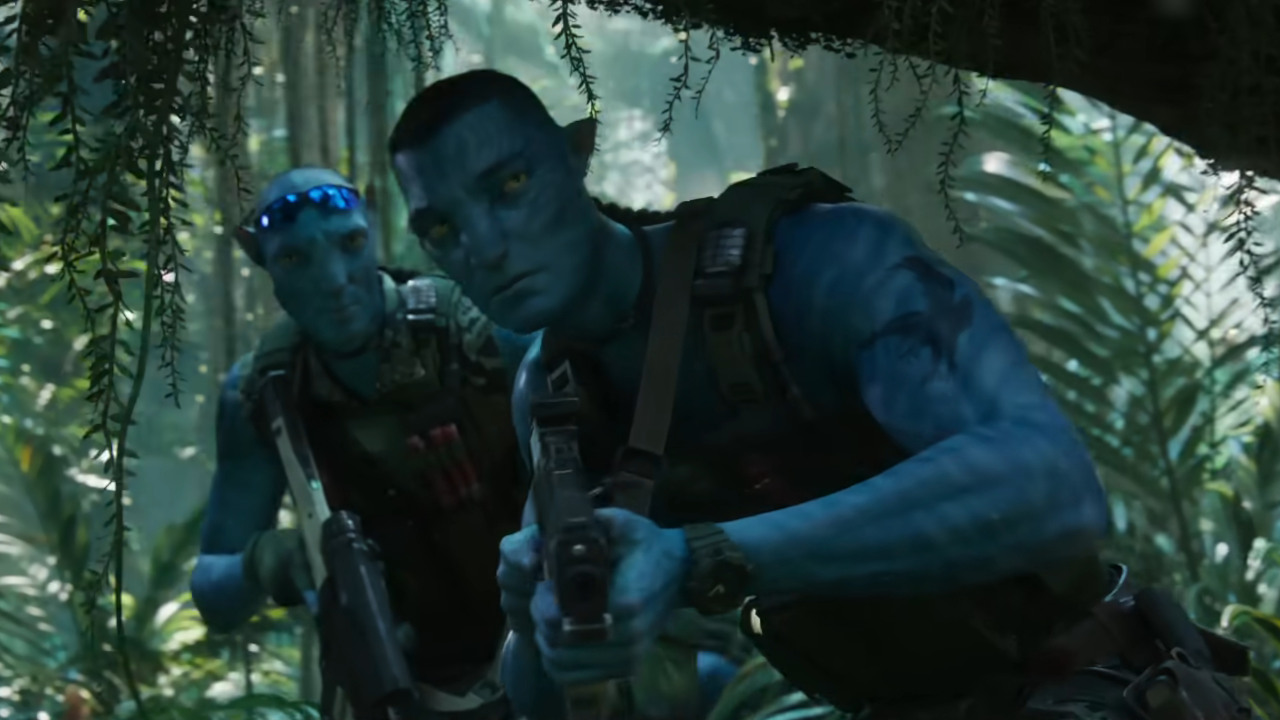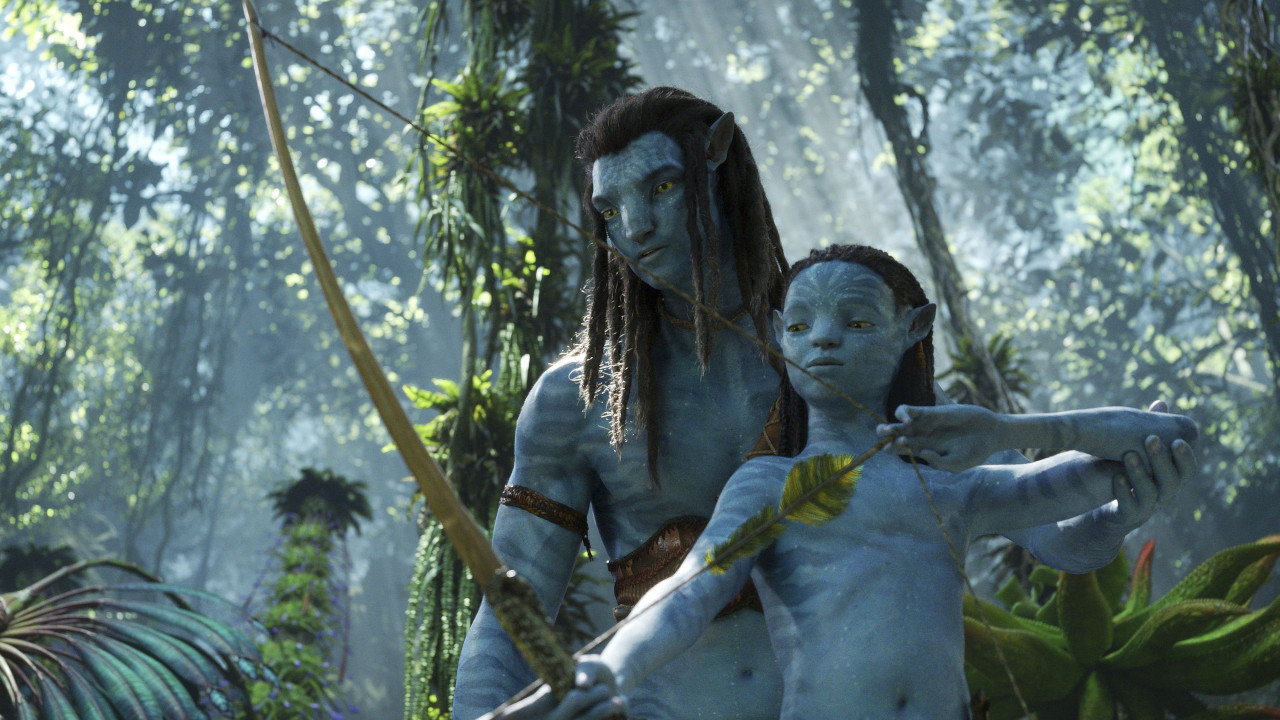13 years ago, James Cameron took the cinema world by storm with an audiovisual feat that would shape blockbusters and the theatre exhibition experience for years to come, Avatar. This achievement surpassed the world’s previously highest-grossing film, also by Cameron, Titanic, and by the end of its multiple cinematic runs, it grossed a magnificent 2.922 billion USD. It featured a disabled veteran volunteering to leave his dying home planet Earth for Pandora, a gorgeous, distant moon teeming with light and resources, only to fall in love with its native people and become one with them.
This film was never considered a massive storytelling achievement but was a monolithic example of strong visual effects, pioneering stereoscopic 3D, and engaging sci-fi high-concept action. But it was also a clear environmentalist commentary while touching on themes of identity, loyalty, and spirituality. After 13 long years of countless superhero blockbusters later, it might be easy to forget the influence of this film. Still, in those years, Cameron had something cooking, a mighty 4 sequels to his greatest success. Out of this, new filmmaking technological advancements were made, and Avatar: The Way of Water was born.
Transhumanism at Its Finest

Much like the first Avatar, The Way of Water explores the philosophies surrounding the idea of casting aside the limitations on our human selves. This idea, under the umbrella of transhumanism, includes ways to circumvent death itself and embrace the idea of leaving the body you’ve known behind. While the first film explores this in the Avatar Program, where humans could have Na’vi (the native humanoid species of Pandora) bodies bearing similar genetic traits, The Way of Water explores the idea of embedding the memory of dead soldiers into avatars. The former was an extension, while the latter, was a facsimile.
Col. Miles Quaritch (Stephen Lang), a fantastic villain from the first film, is brought back to life in this film in an interesting way: his original body was dead, with this bearing his memory and genes. His hatred for Jake Sully (Sam Worthington) is still alive and well, and he quickly adapts to his newfound body, but upon waking up, his instinct on seeing Na’vi looking down on him is to attack, seeing them as the natural enemy. Meanwhile, Jake, who transferred his consciousness to his new body in the first film, has embraced his Omaticaya clan, even building a family with his beloved Neytiri (Zoë Saldaña) in the process. He has instinctively reached out to Na’vi leaders, seeing them as inherently peaceful, wishing only to coexist.
Quaritch and his lackeys quickly adapt, bringing their Na’vi strengths together with human technology and comrades, and actively become greater individual threats. Sully digs his heels in deeper, fleeing to the Metkayina reef-dwelling clan, learning their ways and finding out about the differently-evolved traits of their people. Both choose to adapt using means beyond the possibilities found within their former human selves, with different motivations, and it’s fascinating to see them play out.
Sullys Stick Together

Another prominent theme of this film is family, juxtaposed between Jake’s biological and adopted children. The Sully family loves each other fiercely, fighting on one another’s behalf, and striving to be accepting of one another, especially since they have inherited human genetic traits from Jake.
Jake’s children are Neteyam, the eldest son, Tuktirey, their young daughter, and the teenage Lo’ak, the child most similar to Jake, and thus most heavily scrutinized for his actions. His adopted children are Kiri, a Na’vi born from Grace Augustine’s avatar and an unknown father, and Miles “Spider” Socorro, a human left behind after the events of the first film. Despite Avatar’s big hero being Jake, this film sees his family take center stage for much of the duration, particularly Spider and Lo’ak, to varying degrees of success.
Lo’ak finds difficulty fitting in with the Metkayina, constantly butting heads with other teenagers while they mock him for not having the same developed arms or fin-like tails for swimming, seeing refuge and comfort with a sea-dwelling outcast. Spider, longing for genuine acceptance and acknowledgment, has a complicated relationship with the Sully family, although bonds with Kiri, his fellow adopted sibling, but is manipulated by external forces due to this flaw.
Spider’s heritage is a big plot point, and frankly, a disappointing one revealed too quickly, yet unsurprising to say the very least, while Kiri’s is frustratingly kept obscure for the most part. This leaves a similar feeling to Star Wars: The Force Awakens, but in a way that feels derivative.
Neytiri, one of the greatest aspects of the previous film, also receives less focus, which in my opinion hurts the film already. However, her ferocious motherly love and action-hero fanservice-y moments in battle help make up for it, so if I were to use this critique more diplomatically, I’d say she was used “sparingly.”
Heart of the Ocean

The bulk of this film, particularly its most beautiful parts, takes place just above or below the surface of the seas and depicts James Cameron’s environmentalist angle more interestingly this time around. The Way of Water sees a side of Pandora where the wildlife is wildly alive, aquatic creatures feeling strikingly real yet uncanny and otherworldly, while ultimately familiar and endearing. You begin to feel attached to this wildlife, so it’s especially disheartening when they are treated as bait by the RDA and SecOps.
The film has no shortage of overt examples where human presence is bad for Pandora’s environment, either. There’s a scene very early on in which humans make planetfall and things quickly cut to the surrounding land being incinerated, with an intensity of an Exterminatus ordered by the Imperium of Man, though this isn’t Warhammer 40k. But Cameron’s biggest tug at the heartstrings for environmentalists in the audience is watching the human and recombinant villains’ heartless cruelty to the aquatic wildlife to draw out Sully’s family.
The Sound
Avatar: The Way of Water may be proclaimed as a visual spectacle, but it also has some pretty strong audio design, especially in the underwater segments. Additionally, the music certainly feels different from that of the previous film, due to the unfortunate passing of the original film’s composer, James Horner. Everything hit the ear nicely, thanks in no small part to the massive IMAX sound system built to draw me in and keep me immersed in the action.
However, using Horner’s themes from the first film as well as additional songs in a score created by Simon Franglen, the film feels distinctive. While I appreciate the wonder and awe conveyed by Horner’s theme song, the music felt overplayed in the first film, which may be an unpopular opinion.
The Visuals

This is Avatar’s domain, unequivocally. The visuals of any James Cameron spectacle are clear, and some of his greatest hallmarks as a director. While there are various gripes about the narrative and other aspects of the film, the visuals are undeniable, striking, and spectacular, and I want to see more. I had the pleasure of watching it in IMAX 3D with HFR, resulting in gloriously lit, immersive scenes, with some of the best examples being shots where you could see both above and below the surface simultaneously.
The battle sequences were also tight and exciting, and while the finale wasn’t as explosive and large-scale in its battle as the first one, the emotional stakes were higher than before. The VFX were also way stronger, with my typical issues such as the weird ways eyes were rendered in CGI no longer being present, the characters being natural-looking and expressive, yet resemblant of their real-life acting counterparts. One of my favorite examples of this was seeing Stephen Lang’s scowl on the face of his Na’vi recombinant body, knowing he’s stuck with the traits of a people he viciously hates.
James Cameron had to go through a lot of trouble to create the visuals in particular for this film. Underwater performance and motion capture did not have anything close to something like this before, and it’ll likely have a huge impact on similar film projects or even potential games in the future. Cameron also rigged together a peculiar 3D camera setup for filming this movie as well, and made it with the express intent for screenings in theatres with an IMAX setup, although it can be accommodated by competitor experiences like Dolby or UltraAVX.
But Cameron, while coming off as cocksure as a renowned blockbuster director, does this as a service to the viewers. While other blockbuster directors may want to leave a distinguished footprint or style behind to be remembered, Cameron seemingly wants the future of cinema and how blockbusters are made to be his footprint, and for people to be taken on a journey by his work, with technology made widely available to immerse you as clearly as possible.
The Issues
I have a few glaring issues with Avatar: The Way of Water: the dialogue, mild aspects of the pacing, and flaws in the HFR presentation.
The dialogue of Avatar 2 is fine for the most part, feeling genuine and believable for the most part between humans and Na’vi. But as soon as they try to communicate with the wildlife, it can feel uncomfortable, awkward, or even laughable. Something about a whale-like creature asking a pregnant woman “how is your baby?” just feels inherently awkward and will likely elicit a few snickers. That’s not to say there weren’t parts where it worked, such as Lo’ak’s dialogue with the outcast creature in the film, where you see through the creature’s eyes in a yellow filter as Lo’ak voices his struggles similar to how Jake made his vlogs in the first film. But overall, the dialogue is imperfect at best.
The pacing of the film is naturally going to be a big talking point, especially for those who struggle to find other faults in the film. 3 hours is a long time for a lot of people, and although I’d be happy to sit through a 9-hour film if it were put in front of me and interesting enough (we’re increasingly conditioned to binge entire seasons on Netflix), I get it, that’s a long time without bathroom breaks. That’s what I did, too, and there were sequences where I genuinely got impatient and wondered when they would cut back to the villain’s subplot as too much focus was being given to other supporting characters.
The HFR, while incredibly awesome when it worked, such as for battle sequences and scenes taking place underwater, would falter at points that were impossible not to notice. This is the first movie review for this site, and I thought I’d be getting away from this sort of critique, but I’m forced to say it in a non-game review: there were noticeable drops in the framerate. Despite scenes running in a gorgeous 48fps, with wonderful flight sequences, the latter half of the film had multiple parts where the action would be engrossing and fast-paced, but would cut to the lower 24fps rates yet look even lower, closer to a choppy 15 or below. It’s frustrating because the bulk of the HFR scenes was great, but when they didn’t work, you would immediately notice.
The Verdict

There were only a few minor narrative woes I had about the movie. Certain loose ends are being touched upon in the third film (Edie Falco’s General Ardmore needs more screen time) and Cameron is at least certified to be making that one, if not 2 others after that to follow. I will maintain that at its worst, the dialogue of The Way of Water had points where it just felt dumb, but it had so much heart and there were some great laughs and emotional highs and lows, delivered wonderfully by the characters.
Visually, the film is a spectacular experience and you can enjoy it with or without HFR if you’re worried about missing out on some pretty stunning moments, but I still encourage giving it a shot. It’s not typically charged as an additional premium, so things could be worse. But the film, flaws, and high points combined are important for a simple reason.
Blockbusters are James Cameron’s love language to moviegoers, with his Avatar films as an affirmation of that love, with their CGI environmentalist epic storytelling. He makes these movies for us to enjoy and escape, and this should be met with respect and appreciation. Even if some aspects are imperfect, Cameron pushes the medium forward with every film he makes.
Avatar: The Way of Water released in theaters worldwide on December 16, 2022.











Published: Dec 16, 2022 03:27 pm